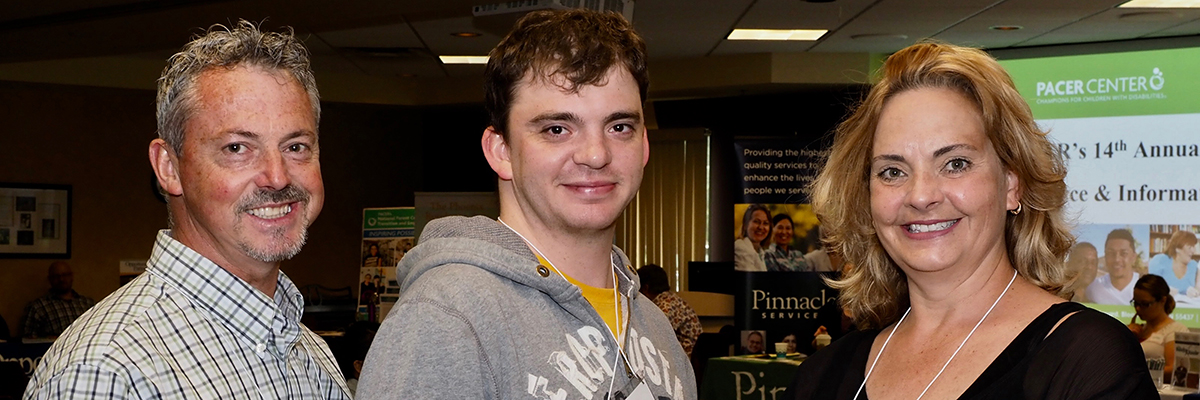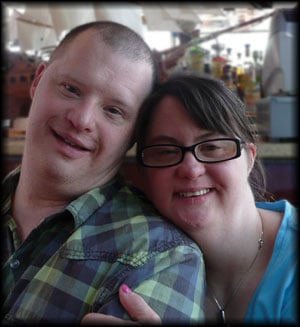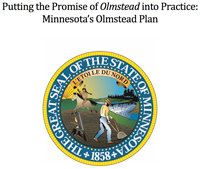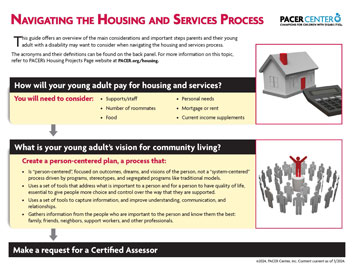
Where Will Our Children Live When They Grow Up?
Many parents of adolescents look forward to the time when their sons or daughters move out of the family home and into homes of their own. This housing guide is written to assist families so they can provide a leading role in planning for housing options for their child with a disability. Many housing options and supports for home living involve meeting eligibility criteria, timelines, waiting lists, and limited availability to obtain financial assistance. One way to help your son or daughter is to begin planning early.
Your Vision for Your Son or Daughter?
The transition your daughter or son makes from childhood to becoming an adult member of the community is a long journey. This journey can be challenging for anyone, but when your son or daughter has a disability, it is important for your family to be intentional about planning. Preparing for home living means more than simply finding a place to live. Preparing for home living is about have a life and a home. What does “home” mean for your son or daughter? What are the everyday rituals and routines that provide him or her with consistency, comfort and control?
The first step in the journey is for you and your daughter or son to discuss the future from each of your perspectives. Be clear with your son or daughter that you are talking about sometime in the future, after they finish school. Starting this process at age 14 may seem premature to some families because at this age, most young people have little or no idea about what they want to do as adults. It’s important to shift your thinking and put your son or daughter in the driver’s sea” so that they are at the center of the planning process. This type of thinking and planning for people with disabilities is called “Person-Centered Planning.” It focuses on the outcomes, dreams, and visions of the individual. This process is driven by an individual’s and family’s unique vision, likes, and dislikes. Person-centered planning uses a set of tools to focus on the people and families rather than programs. It brings together everyone important to the person: family, friends, neighbors, support workers, and other professionals.
After gathering this information, discuss it and develop a plan before thinking about how housing might fit into the picture. As you think about a vision for the future, you and your daughter or son can identify the main considerations for achieving a desirable lifestyle. What are your son or daughter’s hopes and dreams? What level of independence does he or she desire, and what supports will she or he need to achieve these goals? Education, individualized training, successful employment, and an integrated life in the community are some of the essential factors for a young adult to consider. If your daughter or son is unable to express opinions, you and others who know them well can consider strengths and interests and make decisions for her or him.
Information on Person-Centered Thinking and Planning:
- MN Department of Human Services Person-Centered Practices Information Page
Minnesota is moving toward person-centered practices in all areas of service delivery. As a state, Minnesota strives to make sure everyone who receives long-term services and supports and mental health services can live, learn, work and enjoy life in the most integrated setting. The goal is for people to lead lives that are meaningful to them. To do this, we must have a person-centered support system that helps people:- Build or maintain relationships with their families and friends
- Live as independently as possible
- Engage in productive activities, such as employment
- Participate in community life
- What does person-centered mean for me?
An introduction was created with the help of focus groups comprised of people with disabilities and the Disability Linkage Line®. It was created for people with disabilities and their families to help people with disabilities apply person-centered principles to their life. It also helps families and case managers learn and activate person-centered processes. - What are One-Page Profiles? An important tool of introduction to create with your young adult
The purpose of a one-page profile and a person-centered description is to provide a summary of person-centered information that others can use to either get to know the individual quickly or ensure that they are providing consistent support in the way that the person wants. Considering what is important to and for a person, and what good support looks like, can help create actions that make a difference.
The one-page profile provides information to determine what’s working and what’s not working for the person. Even in cases where the individual is not supported by services, this information can still be important to record and share. One-page profiles can be shared with teachers, school staff, family members and friends, support staff, medical providers, and related service providers.
A one-page profile typically has three sections. However, some people in the industry use four sections. PACER has developed an interactive template that you can use. - Helen Sanderson & Associates
Helen Sanderson & Associates is an international development, training and consultancy team. We work with people to change their lives, organizations and communities through Person- Centered thinking and planning. - One-Page Profiles Blog
Follow the individual journeys of people who use services with disabilities, families, and staff. Find out how one-page profiles can help change relationships, as people learn what is important to each other, and increase choice and control, by helping to deliver personalized support. Included are examples and links to create your own one-page profile. - "It's My Choice"
A self-guided workbook on person-centered planning by William T. Allen published by the MN Governor’s Council on Developmental Disabilities. Included is a Housing Checklist. - Person-Centered, Informed Choice and Transition Protocol
Minnesota is driving toward fulfilling the vision of people with disabilities and older Minnesotans living, learning, working, and enjoying life in the most integrated setting. This document is produced by the Minnesota Department of Human Services to communicate expectations regarding person-centered practices with its lead agency partners: counties, tribes and health plans. The Department will work with lead agencies to implement this protocol across the long-term supports and services and mental health services systems. - Minnesota Statues 2013 245D.07 Subd. 1A
Requirements for Person Centered Planning and Service Delivery - U of MN Research & Training Center on Community Living: Person Centered Resources
- Inclusion Press
Inclusion Press creates person centered resource materials for training events, public schools, high schools, community colleges, universities, human service agencies, health organizations, government agencies, families, First Nations organizations - nationally and internationally. - What Is a PATH?
This video by North Star Paths includes an overview of the person centered planning process using the PATH tool. Person Centered Planning helps people identify their vision for the future. It can be used when people are ready to move, get a new job, connect with the community, build relationships, or experience a significant life event. - Person Centered Planning Funds Through Hennepin County
This video features an overview of the person-centered thinking and planning process, highlighting some of the many planning types available: MAPS, PATHS, Picture of a Life, Personal Futures Planning, Essential Life Planning. Included are funding sources and process to access them in Hennepin County.
Your Daughter or Son’s Housing Preferences

Because housing is an integral part of person-centered vision and plan, it is best to begin by asking your son or daughter where he or she wants to live. If your daughter or son has not had an opportunity to understand his or her housing options, you may want to visit friends and families who live in different settings in your community. This will help your son or daughter understand the difference in housing choices.
Consider the following questions when thinking about housing options. First, write your answers to the questions below. Discuss the questions with your son or daughter and write down their responses to the same questions. Be honest with your son or daughter that sometimes we may not be able to have all the things we want, but ask he or she shares the “must-haves.” Remember, person-centered thinking requires us to approach this from your son or daughter’s viewpoint:
- Where does your son or daughter want to live?
- What does your daughter or son need to be happy?
- What are the rituals and routines that bring your son or daughter consistency, comfort and control?
- Can he or she live alone or is support needed?
- How much support does your daughter or son need now?
- What are the characteristics of those who will best support your son or daughter?
- Do you need to consider any health and safety issues?
- Will your son or daughter need to live close to family as part of his or her support system?
- Would your daughter or son like to live by him- or herself or with roommates?
- What kinds of housing options are available in the community?
- What is the neighborhood like? Is the residence accessible? Is it affordable? Is it near transportation?
- What resources are available to pay for housing?
Moving out can be an exciting time, yet it can be a time of concern for any young adult. Addressing your daughter or son’s joys and fears is a necessary part of the process. It is a time to start looking at your son or daughter as an individual and as part of the larger community. It is also a time to celebrate his or her accomplishments.
On the other hand, discussing fearful situations your daughter or son might encounter when they are on their own can help you anticipate and plan for social, safety, and economic concerns. Concerns may include maintaining the appropriate supports, separation from the family, vulnerability, social isolation, and the ability to be employed. It is important to explain that everyone has fear of the unknown and experiences risks and failures. Some fears are realistic and others may not be. Actively seeking out information and networking with parents and friends can help alleviate some fears.
Resources
- Navigating the Maze of Housing and Services: Terminology You Need to Know
As you and your young adult enter the adult services system, you will encounter an array of new terms, acronyms, and processes. Using and understanding key terminology like the following will help you advocate for what your son or daughter needs and clarify what you are asking for.
Linking Your Vision to the Individualized Education Program (IEP) Transition Process

While you and your daughter or son are considering the important factors of her or his vision and long-term goals, your child will be entering a school process called transition. In Minnesota, transition planning and services begin during ninth grade. According to federal law, transition planning must begin by age 16. Transition services are designed with the goal of helping the student move from school to adult life. Students can use this time to succeed by their own efforts and learn from their mistakes.
By starting to plan early, students will have enough time to explore interests and abilities in each transition area:
- Postsecondary education and training
- Employment
- Independent living, including recreation and leisure, community participation, and home living.
When you coordinate your son or daughter’s vision with the transition process, you can use your time wisely by increasing your knowledge of services for young adults with disabilities. You can also begin to familiarize yourself with services in your community and how they fit into your daughter or son’s vision for the future. By networking with school representatives, transition committees, and rehabilitation counselors, you can begin to see how they can help the vision become reality.
This is a time to consider your son or daughter’s independent living skills and their impact on services provided to your son or daughter in whatever housing option he or she chooses in the community of his or her choice. Remember that independence, for some, may not mean establishing a complete mastery of a skill. Some skills may be difficult to master for young adults with disabilities and some young people may need help on an extended basis. Performing a skill independently will look different for each individual depending on his or her level of support. What your daughter or son learns and masters today may affect the kinds of supports and services she or he will need later. This can be a time when you and your son or daughter can practice these skills in a more purposeful, structured way.
Can your daughter or son not only wash the laundry but separate, fold, and put it away in the proper place? Can your son or daughter use basic appliances and tools? Does he understand how to take care of his clothing, groom himself appropriately, go shopping, manage his money, and take care of his medical needs? How does your daughter relate to others? Some young adults may need the components of these tasks to be broken down into manageable steps. Thinking about these questions can help you define your vision.
Self-advocacy skills are very important when your young adult lives in his or her own home. The ability to speak up in order to have one’s wants and needs honored is crucial; developing self- advocacy skills may be an appropriate goal in your daughter or son’s Individualized Education Program (IEP). Parents may need to serve in this role to facilitate communication if their son or daughter is unable.
The IEP can be used to address your daughter or son’s need for independent living skills, but families also should consider how they can help their son or daughter learn as much self-care as possible. The reality is that you, as a parent, may need to take the leading role in deciding on or seeking housing options for your young adult.
Factors That Will Impact Your Son or Daughter's Housing Plan

It’s not always easy to find a desirable place to live that is affordable, accessible, and available. Additional support for young adults is often complicated and costly. Each individual and family is unique; there is no blueprint, or model, for securing housing and support.
Individuals with disabilities now have a greater choice in where they can live. However, not all people with disabilities qualify for housing and services funding. Funding is provided to those who meet the eligibility criteria established by the State of Minnesota. Some funding is an “entitlement”, but may have waiting lists. The following factors will impact your options:
- Your son or daughter’s person-centered vision and plan
- Your daughter or son’s resources: Wages, trusts, Supplemental Security Income (SSI), Social Security Disability Insurance (SSDI), county services, Medical Assistance, Home and Community-Based Waivers, Personal Care Assistant (PCA), home care, nursing services
- Your personal ability to commit resources: Financial, time, energy, and networks
- Community resource options: Availability of suitable housing, community development, accessible housing, low-income or Section 8 housing
- State resources: State housing finance agency and county housing staff, rental assistance programs, home ownership, Fix Up Program fund resources and state disability resources
New Housing Options and Service Systems Choices
Exciting new changes in the way a person with a disability can access housing and services have emerged, and others are being developed. A new system is evolving of self-directed models or “supportive housing.” These new models seek to provide the same supportive services for a person with disabilities in more integrated settings in the community. This new emphasis is actually a renewed government commitment to implement the “Olmstead Decision.” Living in the community is more satisfying for people and is more cost effective than living in institutions.

Olmstead Decision
In 1999, the U.S. Supreme Court in the Olmstead v. L.C. decision interpreted the Title II of the American with Disabilities Act (ADA) to include supporting people with disabilities in the most integrated setting possible. The decision applies to people of any age who have a disability. The Olmstead v. L.C. decision played an important role in the expansion of consumer-directed services in Minnesota and other states.
The Olmstead v. L.C. Decision requires federal, state, and local governments to develop more opportunities for individuals with disabilities through accessible systems of cost-effective community- based services. Olmstead is particularly relevant in assisting transition-age youth with significant disabilities, who are aging-out of government healthcare programs that serve children or exiting special education settings as they access community-based adult services. Youth, their families, and advocates can use the Olmstead Decision to advocate that programs and services be provided “in the most integrated setting possible.”
The goal of this integration mandate in Title II of the ADA is to provide opportunities for individuals with disabilities to live their lives like individuals without disabilities, integrated into the community and not segregated in institutions such as nursing homes. Because of Olmstead, states are able to create individualized housing and service models. A major barrier to states complying with Olmstead is a lack of affordable accessible housing, and access to home and community-based services to support community- based living.
Minnesota’s Olmstead Plan
In 2012, Minnesota formed the Olmstead Planning Committee, which included people with disabilities, family members, providers, advocates, and decision-makers from the Minnesota Department of Human Services (MN DHS). In January, 2013, Governor Mark Dayton issued Executive Order 13-01 which established a subcabinet to develop and implement a comprehensive plan supporting freedom of choice and opportunity for people with disabilities.
The Olmstead Subcabinet embraces the Olmstead Decision and strives to ensure that Minnesotans with disabilities will have the opportunity, both now and in the future, to live more independently in communities of their choice, engage in productive employment, and participate in community life.
To make the promise of Olmstead a reality in Minnesota, the subcabinet has adopted a vision statement to guide the Plan’s implementation: “Minnesota will be a place where people with disabilities are living, learning, working, and enjoying life in the most integrated setting.”

The Minnesota Olmstead Plan is organized into 13 topic areas that cover different aspects of improving the quality of life for people with disabilities. They are:
-
Person Centered Planning
This supports all other topic areas with goals that increase the use of practices, beginning with listening to individuals about what is important to them in creating and maintaining a community life they personally value. -
Transition Services | Housing and Services | Employment | Lifelong Learning & Education | Timeliness of Waiver Funding
These topic areas contain goals that focus on increasing movement of people with disabilities from segregated to integrated settings. -
Transportation | Healthcare & Healthy Living | Positive Supports | Crisis Services | Assistive Technology | Preventing Abuse and Neglect
These topic areas contain goals that focus on building capacity of programs, practices and resources that will support people with disabilities as they live, work and learn in the settings they choose. Community Engagement
This topic area contains goals that focus on engaging people with disabilities in multiple aspects of community life and decision making.
Promoting Supports in Integrated Settings and the Home and Community-Based Services (HCBS) Rule
Concurrently with the Olmstead Plan implementation, the federal government’s Centers for Medicare & Medicaid Services (CMS) released the Home and Community-Based Services (HCBS) rule, which says that all people in the United States receiving publicly paid long-term services and supports must receive those supports in the most integrated setting and have full access to the benefits of community living.
The rule applies to people who receive services through the Brain Injury, Community Alternative Care, Community Access for Disability Inclusion, Developmental Disabilities waivers or the Elderly Waiver, or the upcoming Community First Services and Supports program. The rule has requirements for person-centered planning, service settings and opportunities for involvement in the community.
The Home and Community-Based Services (HCBS) rule requires that a person with a disability and his or her legal representative:
- Have enough information to make informed choices about the type of services he or she receives
- Are treated with respect and in a person-centered way so he or she can make decisions about how, when, and where to receive services
- Have the opportunity to be involved in his or her community, including living and working in integrated settings and coming and going when and where he or she wants
The rule’s aim is to create higher standards for new settings and services and encourage the development of alternative approaches that support inclusive community models.
A key requirement for states is to create a “transition plan” to come into compliance with the new Home and Community-Based Services (HCBS) rule and decide if settings have institutional qualities, including where they are located and if they isolate people from the broader community. Institutional settings like hospitals, Institutions for Mental Disease (IMD) Intermediate Care Facilities for people with Developmental Disabilities (ICF/DD) and nursing facilities are not home and community-based. Examples of settings that have the effect of isolating people are: Farmsteads or disability- specific farm communities; gated or secured “communities” for people with disabilities; residential schools; and multiple settings that are co-located or operationally related and congregate a large number of people with disabilities together and provide for significant shared programming and staff, so that people’s ability to interact with the broader community is limited.
If the state decides some settings are institution-like, it can either present information to Centers for Medicare & Medicaid Services (CMS) about why the setting should be allowed, or, if the setting is unable to meet the new standards, identify a process to support the person to locate other service and settings options.
Additional Requirements for Community Residential and Non-residential Settings
Additional requirements apply to provider owned or controlled residential settings (corporate adult foster care or “group homes”), that relate to qualities such as community integration, rights and informed choice. Just as people without disabilities can enjoy housing of their choice, your son or daughter must have a lease or similar legally enforceable agreement that includes the same responsibilities and protections from eviction as all tenants in their jurisdiction enjoy. This means that your daughter or son should not be at risk for losing her or his housing due to disability discrimination. These rules are required to assure that your son or daughter has control of their own home.
A community living setting must allow your daughter or son to:
- Have a lease or other legally enforceable agreement
- Have privacy in their unit: lockable doors, choice of roommates, and freedom to furnish or decorate the unit
- Have control of his or her own schedule, including access to food at any time
- Have visitors at any time
- Have a physically accessible setting
It is important to note that any modification of the above must be supported by a specific assessed need and documented in the person-centered service plan.
The new rule also applies to non-residential day services provided through a Home and Community-Based Waiver, including Adult Day Services, Day Training and Habilitation (DT&H), Pre- vocational Services and Structured Day Services.
CMS required each state to create a transition plan detailing how the state will come into compliance with the new Home and Community-Based Services and Settings rule. Minnesota received final approval of its Statewide Transition Plan (STP) on February 8, 2019. Although the implementation of the Home and Community-Based (HCBS) rule transition plan only applies to those receiving HCBS services, their goals and strategies are aligned to Minnesota’s Olmstead Plan that applies to all people with disabilities. The ultimate vision is that “Minnesota will be a place where people with disabilities are living, learning, working, and enjoying life in the most integrated setting.”
Apply for County Social Service Case Management In Minnesota
Find your county's social services website here
Contact numbers / Minnesota Department of Human Services (mn.gov) ![]()
Continued ...

